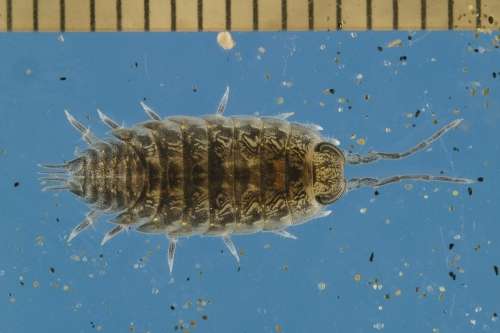New evidence animal behaviour regulated by interaction of tidal and circadian clocks

A slater-like crustacean that lives in the sand on Auckland's Piha beach has provided new evidence that animals have biological clocks influenced by the tide as well as the more familiar circadian clock that follows the day/night cycle and which regulates human behaviour.
While the molecular mechanism of the circadian clock in humans is well known, including its location in the human brain and the genes involved, the mechanisms of other biological clocks are not.
Many animals are known to have "extra" biological clocks that regulate feeding or reproduction according to the tide or lunar cycle but scientists have been unsure of how they work, particularly over longer periods.
Senior Lecturer James Cheeseman from the Faculty of Medical and Health Sciences and Professor Mike Walker from the School of Biological Sciences at the University of Auckland carried out a study of Scyphax ornatus, a nocturnal sand-burrowing isopod that feeds on the plant and animal detritus that is moved up the beach by the incoming tide.
Leaving their burrows only at night, the animals need to maximise the amount of time for feeding before the tide comes in. In the wild, they appear able to follow a semilunar or approximately fortnightly feeding cycle, meaning something other than the circadian clock must be regulating their behaviour.
Taking the animals from Piha into the laboratory, the study used artificially manipulated light and tidal cycles to test several hypotheses for the mechanism of the semilunar clock that controls their behaviour.
The study found the animals followed internal biological clocks even when deprived of external stimuli.
"What we have found is that, in the laboratory, with light and tide cycles artificially manipulated, these animals follow the same rules of behaviour as they would in the wild," says Dr Cheeseman. "So we can very accurately change the semilunar rhythm by changing the perceived length of the day and tidal cycles.
"That tells us their semilunar or fortnightly behaviour continues to be regulated by the interaction of circatidal and circadian clocks even where there is either no external stimuli or they are in an environment with artificial light cycles or tidal cycles."
Professor Walker said circalunar and circatidal behaviour in animals was well known by early Maori who followed a fishing and planting calendar over the circalunar cycle.
The study is published in Scientific Reports: "Circadian and circatidal clocks control the mechanism of semilunar foraging behaviour".
More information: James F. Cheeseman et al. Circadian and circatidal clocks control the mechanism of semilunar foraging behaviour, Scientific Reports (2017). DOI: 10.1038/s41598-017-03245-3
Journal information: Scientific Reports
Provided by University of Auckland





















